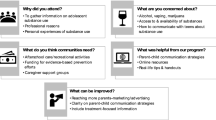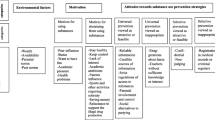Abstract
Evidence-based interventions to reduce substance misuse among adolescents are resource and time intensive. We conducted a pilot randomized controlled trial to evaluate a novel, adaptable, and resource-efficient substance misuse preventive intervention for parents/guardians, focusing on talking with children about substance use and eating family meals. We randomized 70 parents of children in third-through-sixth grades within a large, urban public school system in New England to the intervention or control condition. Over a 6-month follow-up period, we assessed feasibility and acceptability of the intervention and examined frequency of parent–child conversations about alcohol, marijuana, and other drugs, and frequency and duration of family meals. A total of 29 parents were assigned to the intervention and 35 to the control condition. The intervention was found to be feasible and acceptable to participants as evidenced by high recruitment and retention rates and positive feedback from qualitative exit interviews. At 3-month and 6-month follow up, 64.3 % and 44.5 % of parents in the intervention condition were talking “a lot” to their children about alcohol, compared to 8.7 % and 8.7 % of the parents in the control condition, respectively (p < 0.01 and p = 0.03). Patterns in frequency and duration of family meals between the two conditions were not significantly different over time. In conclusion, a higher percentage of parents randomized to the intervention condition spoke with their children about alcohol, marijuana, and other drugs, but the frequency and duration of meals was not impacted. Further testing of the brief intervention with a larger sample to assess efficacy is warranted.

Similar content being viewed by others
References
Bauman, K. E., Foshee, V. A., Ennett, S. T., Pemberton, M., Hicks, K. A., King, T. S., & Koch, G. G. (2001). The influence of a family program on adolescent tobacco and alcohol use. American Journal of Public Health, 91, 604–610.
Berge, J. M. (2009). A review of familial correlates of child and adolescent obesity: what has the 21st century taught us so far? International Journal of Adolescent Medicine and Health, 21, 457–483.
Bray, J. H., Adams, G. J., Getz, J. G., & Stovall, T. (2001). Interactive effects of individuation, family factors, and stress on adolescent alcohol use. American Journal of Orthopsychiatry, 71, 436–449.
Brody, G. H., Flor, D. L., Hollett-Wright, N., & McCoy, J. K. (1998). Children’s development of alcohol use norms: Contributions of parent and sibling norms, children’s temperaments, and parent–child discussions. Journal of Family Psychology, 12(2), 209–219.
Brody, G. H., Murry, V. M., Kim, S., & Brown, A. C. (2002). Longitudinal pathways to competence and psychological adjustment among African American children living in rural single-parent households. Child Development, 1505-1516.
Cook, R. L., Comer, D. M., Wiesenfeld, H. C., Chang, C. C., Tarter, R., Lave, J. R., & Clark, D. B. (2006). Alcohol and drug use and related disorders: an underrecognized health issue among adolescents and young adults attending sexually transmitted disease clinics. Sexually Transmitted Diseases, 33, 565–570.
Dembo, R., Williams, L., Schmeidler, J., Wish, E. D., Getreu, A., & Berry, E. (1991). Juvenile crime and drug abuse: a prospective study of high risk youth. Journal of Addictive Diseases, 11, 5–31.
Dishion, T. J., Reid, J. B., & Patterson, G. R. (1988). Empirical guidelines for a family intervention for adolescent drug use. Journal of Chemical Dependency Treatment, 1, 189–224.
Flory, K., Lynam, D., Milich, R., Leukefeld, F., & Clayton, R. (2004). Early adolescent through young adult alcohol and marijuana use trajectories: early predictors, young adult outcomes, and predictive utility. Developmental Psychopathology, 16, 193–213.
Franko, D. L., Thompson, D., Affenito, S. G., Barton, B. A., & Striegel-Moore, R. H. (2008). What mediates the relationship between family meals and adolescent health issues. Health Psychology, 27(2S), S109.
Fulkerson, J. A., Story, M., Mellin, A., Leffert, N., Neumark-Sztainer, D., & French, S.A. (2006). Family dinner meal frequency and adolescent development: relationships with developmental assets and high-risk behaviors. Journal of Adolescent Health, 39(3), 337–345.
Ge, X., Best, K. M., RD, C., & RL, S. (1996). Parenting behaviors and the occurrence and co-occurrence of adolescent depressive symptoms and conduct problems. Developmental Psychology, 32, 717–731.
Hawkins, J. D., Catalano, R. F., & Miller, J. Y. (1992). Risk and protective factors for alcohol and other drug problems in adolescence and early adulthood: implications for substance abuse prevention. Psychological Bulletin, 112, 64–105.
Kann, L., Kinchen, S., Shanklin, S. L., Flint, K. H., Kawkins, J., & Harris, W. A., et al. (2014). Youth risk behavior surveillance—United States, 2013. Morbidity and Mortality Weekly Report Surveillance Summaries, 63(Suppl 4), 1–168.
Kumpfer, K. L., Alvarado, R., & Whiteside, H. O. (2003). Family-based interventions for substance use and misuse prevention. Substance Use & Misuse, 38, 1759–1787.
McGue, M., Iacono, W. G., Legrand, L. N., Malone, S., & Elkins, I. (2001). Origins and consequences of age at first drink. I. associations with substance-use disorders, disinhibitory behavior and psychopathology, and P3 amplitude. Alcoholism: Clinical and Experimental Research, 25, 1156–1165.
Miller, M. A., Alberts, J. K., Hecht, M. L., Trost, M., & Krizek, R. L. (2000). Adolescent relationships and drug use. Mahwah, NJ: Lawrence Erlbaum Assoc.
Miller-Day, M., & Kam, J. A. (2010). More than just openness: developing and validating a measure of targeted parent–child communication about alcohol. Health Communication, 25(4), 293–302.
Molgaard, V., & Kumpfer, K. L. (1994). Strengthening families program II. Ames, IA: Iowa State University, Social and Behavioral Research Center for Rural Health.
Molgaard, V. M., Spoth, R., & Redmond, C. (2000). Competency training: The Strengthening Families Program for parents and youth 10-14. Washington, DC: U.S. Department of Justice, Office of Juvenile Justice and Delinquency Prevention.
Musick, K., & Meier, A. (2012). Assessing causality and persistence in associations between family dinners and adolescent well-being. Journal of Marriage and Family, 74, 476–493.
National Center on Addiction and Substance Abuse (CASA). (2012). The Importance of Family Dinners VIII. New York, NY: Columbia University.
National Institute on Drug Abuse, National Institutes of Health & U.S. Department of Health and Human Services (NIDA) (2014). DrugFacts: lessons from prevention research. http://www.drugabuse.gov/publications/drugfacts/lessons-prevention-research. Accessed 14 November 2015.
Neumark-Sztainer, D., Hannan, P. J., Story, M., Croll, J., & Perry, C. (2003). Family meal patterns: associations with sociodemographic characteristics and improved dietary intake among adolescents. Journal of the American Dietetic Association, 103, 317–322.
O’Connell, M. E., Boat, T., & Warner, K. E. (2009). In committee on the prevention of mental disorders and substance abuse among children, youth and young adults: research advances and promising interventions (Ed.), Preventing mental, emotional, and behavioral disorders among young people: Progress and possibilities. Washington, DC: The National Academies Press.
Park, J., Kosterman, R., Hawkins, J. D., Haggerty, K. P., Duncan, T. E., Duncan, S. C., & Spoth, R. (2000). Effects of the “Preparing for the Drug Free Years” curriculum on growth in alcohol use and risk for alcohol use in early adolescence. Prevention Science, 1, 125–138.
Perry, C. L., Williams, C. L., Komro, K. A., Veblen-Mortenson, S., Stigler, M. H., Munson, K. A., & Forster, J. L. (2002). Project northland: Long-term outcomes of community action to reduce adolescent alcohol use. Health Education Research, 17(1), 117–132.
Robinson, S. M., Sobell, L. C., Sobell, M. B., & Leo, G. I. (2014). Reliability of the timeline followback for cocaine, cannabis, and cigarette use. Psychology of Addictive Behaviors, 28, 154–162.
Sen, B. (2010). The relationship between frequency of family dinner and adolescent problem behaviors after adjusting for other family characteristics. Journal of Adolescence, 33(1), 187–196.
Skeer, M. R., & Ballard, E. L. (2013). Are family meals as good for youth as we think they are? A review of the literature on family meals as they pertain to adolescent risk prevention. Journal of Youth and Adolescence, 42(7), 943–963.
Skeer, M., McCormick, M. C., Normand, S. L., Buka, S. L., & Gilman, S. E. (2009). A prospective study of familial conflict, psychological stress, and the development of substance use disorders in adolescence. Drug and Alcohol Dependence, 104, 65–72.
Smit, E., Verdurmen, J., Monshouwer, K., & Smit, F. (2008). Family interventions and their effect on adolescent alcohol use in general populations; a meta-analysis of randomized controlled trials. Drug and Alcohol Dependence, 97(3), 195–206.
Spoth, R. L., Redmond, C., Trudeau, L., & Shin, C. (2002). Longitudinal substance initiation outcomes for a universal preventive intervention combining family and school programs. Psychology of Addictive Behaviors, 16(2), 129–134.
Spoth, R., Randall, G. K., Shin, C., & Redmond, C. (2005). Randomized study of combined universal family and school preventive interventions: Patterns of long-term effects on initiation, regular use, and weekly drunkenness. Psychology of Addictive Behaviors, 19, 372–381.
Spoth, R. L., Redmond, C., & Shin, C. (2001). Randomized trial of brief family interventions for general populations: adolescent substance use outcomes 4 years following baseline. Journal of Consulting and Clinical Psychology, 69, 627–642.
Stout, R. L., Wirtz, P. W., Carbonari, J. P., & Del Boca, F. K. (1994). Ensuring balanced distribution of prognostic factors in treatment outcome research. Journal of Studies on Alcohol, Supplement, 12, 70–75.
Szapocznik, J., & Coatsworth, J. D. (1999). An ecodevelopmental framework for organizing the influences on drug abuse. In M. Glantz & C. Hartel (Eds.), A developmental model of risk and protection (pp. 126-143). Washington, DC: American Psychological Association.
Vakalahi, H. F. (2001). Adolescent substance use and family-based risk and protective factors: a literature review. Journal of Drug Education, 31, 29–46.
Werch, C. E., Owen, D. M., Carlson, J. M., DiClemente, C. C., Edgemon, P., & Moore, M. (2003). One-year follow-up results of the STARS for families alcohol prevention program. Health Education Research, 18, 74–87.
Woodruff, S. J., & Hanning, R. M. (2008). A review of family meal influence on adolescents’ dietary intake. Canadian Journal of Dietetic Practice and Research, 69, 14–22.
World Health Organization (WHO) (2008). The effectiveness of a brief intervention for illicit drugs linked to the alcohol, smoking, and substance involvement screening test (ASSIST) in primary health care settings: a technical report of phase III findings of the WHO ASSIST Randomized control trial. http://www.who.int/substance_abuse/activities/assist_technicalreport_phase3_final.pdf. Accessed 8 August 2016.
Author information
Authors and Affiliations
Corresponding author
Ethics declarations
Conflict of interest
The authors declare that they have no competing interests.
Rights and permissions
About this article
Cite this article
Skeer, M.R., Yantsides, K.E., Eliasziw, M. et al. Testing a Brief Substance Misuse Preventive Intervention for Parents of Pre-Adolescents: Feasibility, Acceptability, Preliminary Efficacy. J Child Fam Stud 25, 3739–3748 (2016). https://doi.org/10.1007/s10826-016-0525-3
Published:
Issue Date:
DOI: https://doi.org/10.1007/s10826-016-0525-3




